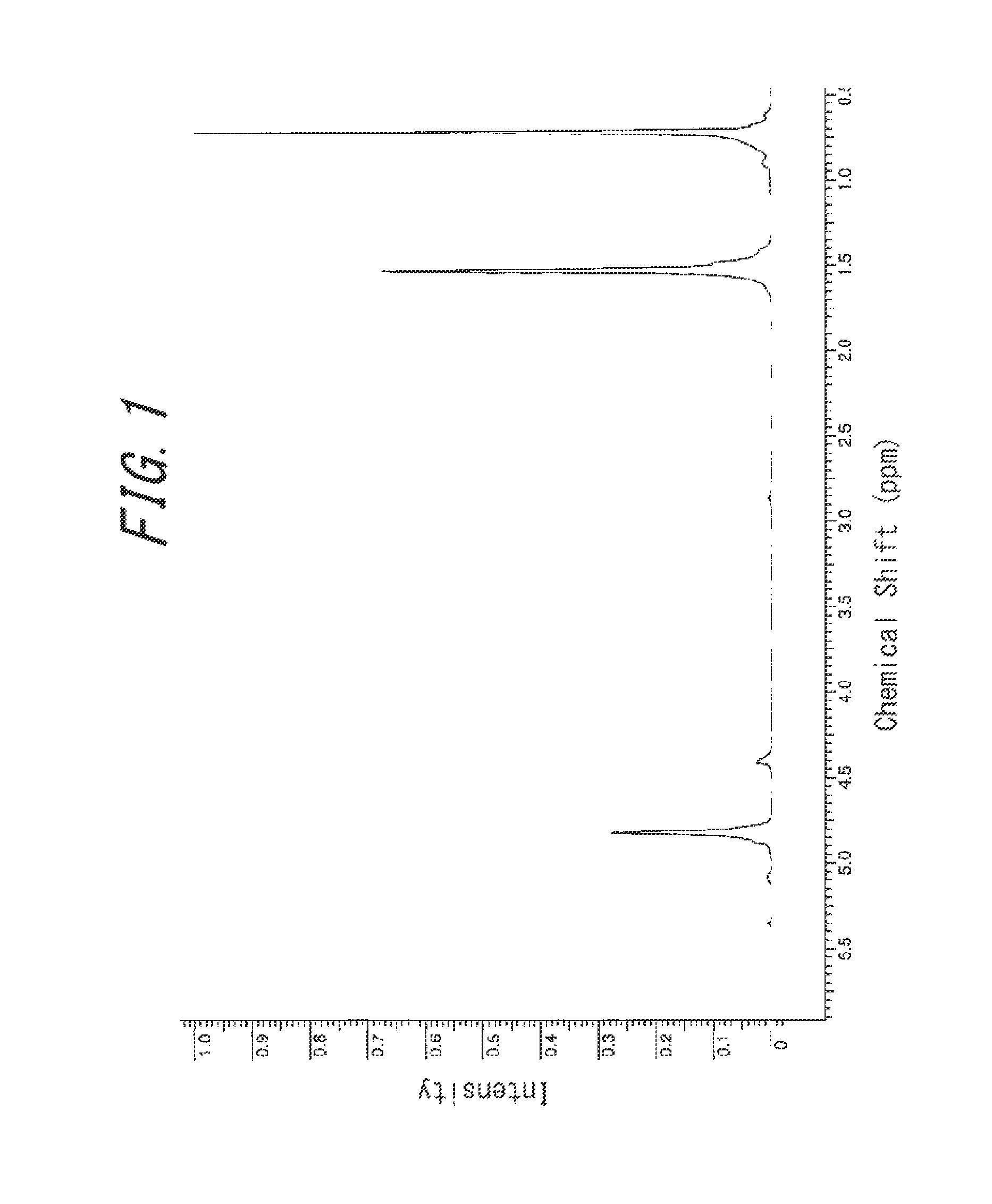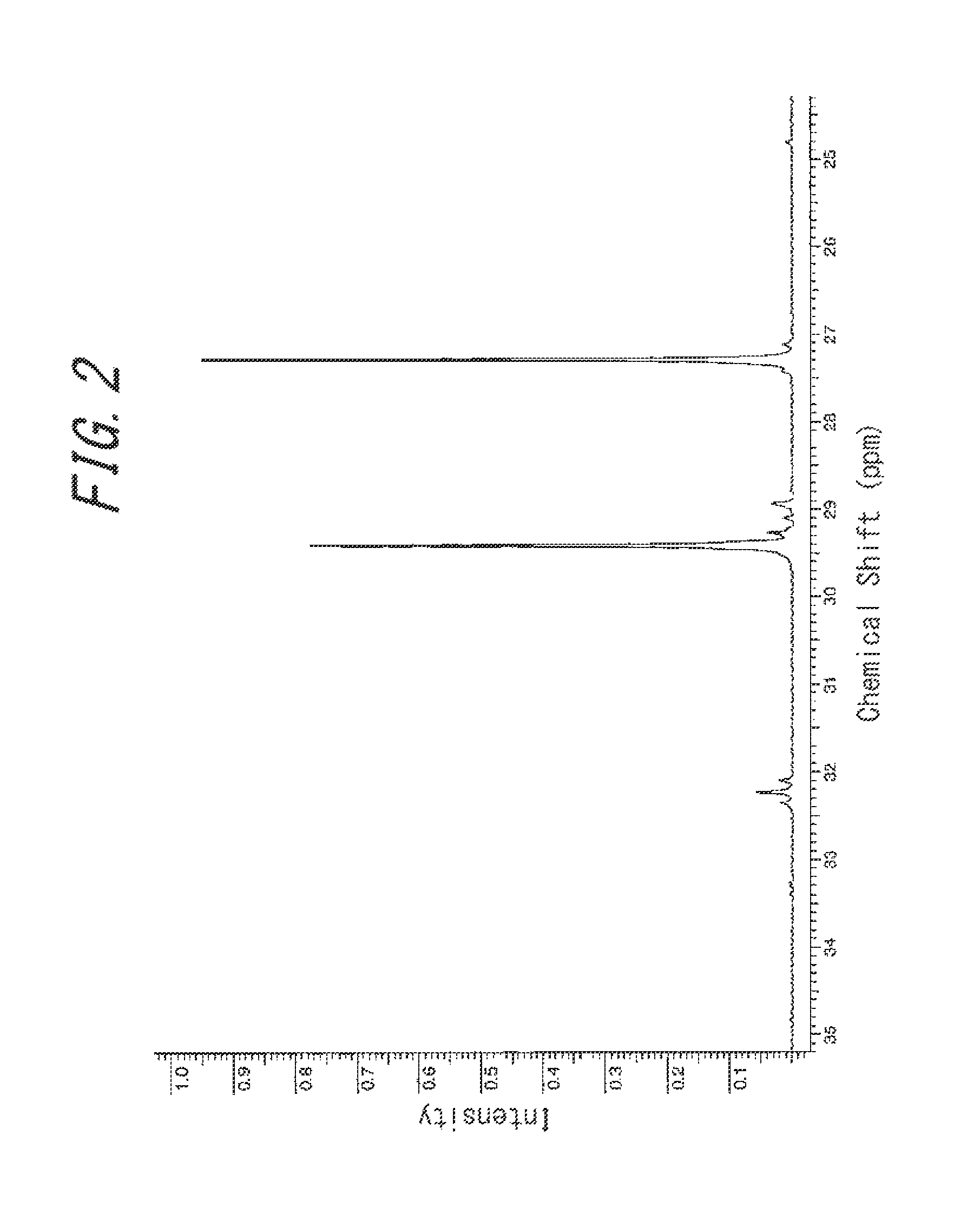Copolymer and method of manufacturing the same
a copolymer and copolymer technology, applied in the field of copolymer and a method of manufacturing the same, can solve the problems of limited structure of the obtained polymer, low catalytic activity, and difficulty in providing efficient copolymerization of olefins and dienes using such catalyst systems
- Summary
- Abstract
- Description
- Claims
- Application Information
AI Technical Summary
Benefits of technology
Problems solved by technology
Method used
Image
Examples
example 1
[0065]Firstly, 300 mL of a toluene solution containing 18.20 g (0.34 mol) of 1,3 butadiene was added to a 400 mL pressure-resistant grass reactor that had been sufficiently dried, and then ethylene was introduced thereto at 0.8 MPa. Meanwhile, in a glovebox under a nitrogen atmosphere, 34.0 μmol of trisbistrimethylsilylamide gadolinium [Gd(N(SiMe3)2)3], 41 μmol of N,N-dimethylanilinium tetrakis(pentafluorophenyl)borate [Me2NHPhB(C6F5)4], and 1.19 mmol of triisobutylaluminum were provided in a glass container, which was dissolved into 8 mL of toluene, to thereby obtain a catalyst solution. After that, the catalyst solution was taken out from the glovebox and added by 33.7 μmol of gadolinium equivalent to the monomer solution, which was then subjected to polymerization at room temperature for 180 minutes. After the polymerization, 1 mL of an isopropanol solution containing, by 5 mass %, 2,2′-methylene-bis(4-ethyl-6-t-butylphenol) (NS-5), was added to stop the reaction. Then, a large a...
example 2
[0066]Polymerization was performed in the same way as that performed in Example 1, except that 4.55 g (0.084 mol) of 1,3-butadiene was used, to obtain a copolymer B. The yield of the copolymer B thus obtained was 22.50 g.
example 3
[0067]Firstly, 300 mL of a toluene solution containing 23.76 g (0.44 mol) of 1,3 butadiene was added to a 400 mL pressure-resistant grass reactor that had been sufficiently dried, and then ethylene was introduced thereto at 0.8 MPa. Meanwhile, in a glovebox under a nitrogen atmosphere, 50 μmol of Gd(N(SiMe3)2)3, 60 μmol of Me2NHPhB(C6F5)4, and 1.50 mmol of diisobutylaluminum hydride were provided in a glass container, which was dissolved into 8 mL of toluene, to thereby obtain a catalyst solution. After that, the catalyst solution was taken out from the glovebox and added by 44 μmol of gadolinium equivalent to the monomer solution, which was then subjected to polymerization at 40° C. for 180 minutes. After the polymerization, 1 mL of an isopropanol solution containing, by 5 mass %, NS-5 was added to stop the reaction. Then, a large amount of methanol was further added to isolate the copolymer, and the copolymer was vacuum dried at 70° C. to obtain a copolymer C. The yield of the cop...
PUM
| Property | Measurement | Unit |
|---|---|---|
| atomic numbers | aaaaa | aaaaa |
| temperature | aaaaa | aaaaa |
| mol % | aaaaa | aaaaa |
Abstract
Description
Claims
Application Information
 Login to View More
Login to View More - R&D
- Intellectual Property
- Life Sciences
- Materials
- Tech Scout
- Unparalleled Data Quality
- Higher Quality Content
- 60% Fewer Hallucinations
Browse by: Latest US Patents, China's latest patents, Technical Efficacy Thesaurus, Application Domain, Technology Topic, Popular Technical Reports.
© 2025 PatSnap. All rights reserved.Legal|Privacy policy|Modern Slavery Act Transparency Statement|Sitemap|About US| Contact US: help@patsnap.com


